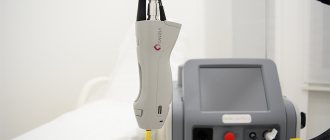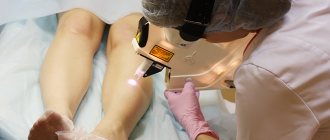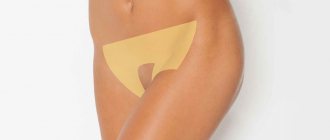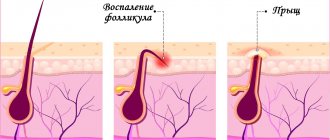Hair removal is an extremely unpleasant process, especially if it is necessary to treat the bikini area. Of course, beauty requires sacrifice - everyone knows this, but there are a few tricks that, although they cannot completely rid you of unpleasant sensations during hair removal, will at least significantly reduce them.
In our hair removal salon, the specialists will do everything possible to make the process of removing hair from the bikini area as comfortable as possible for you. There are several effective methods that can achieve a good analgesic effect.
Emla cream: composition and mechanism of action on the skin
Why does a person experience pain? In general, this feeling performs a kind of protective function in the body. When the skin is injured or otherwise damaged, the nerve endings immediately send an impulse to the brain about it. Thus, the biological meaning of pain is that it instantly mobilizes the body for self-preservation.
The epilation process is always accompanied by painful sensations
However, pain becomes a serious obstacle during some beauty procedures, in particular during hair removal or depilation, when hairs are removed, damaging the hair follicle, or pulled out along with the root. In this case, Emla cream is often used, which blocks the nerve endings, as a result of which the brain does not receive any alarm signals.
The drug contains the anesthetic components lidocaine and prilocaine. Lidocaine exhibits its analgesic properties much faster than prilocaine, but its duration of action is shorter than that of the second anesthetic.
The combination of these two components in Emla provides, although not instantaneous, a relatively quick and fairly long-lasting effect, which allows epilation or depilation over large areas of the skin.
Research shows that Emla is a highly effective drug. 91% of women noted complete pain relief after applying the cream. The remaining 9% experienced minor pain. This could be due to the use of an insufficient amount of the drug, or the exposure time was incorrectly chosen .
Another reason for inadequate anesthesia may be a physiological feature of the skin: the thicker the skin, the longer it takes the drug to reach the nerve endings. Therefore, in this case, the application time of Emla should be increased so that the components of the drug can penetrate the skin layers as deeply as possible.
Lidocaine spray
Probably the most popular pain reliever is lidocaine, which has been used in local and general surgery for several decades. This drug is a simple, effective and affordable anesthetic.
In almost any pharmacy you can buy lidocaine spray, which perfectly anesthetizes the surface of the skin. Unfortunately, using a spray it is impossible to achieve the same effect as with injection, because the sensitivity of the skin surface decreases, but not the subcutaneous layer, where the hair follicles are located.
Use of the drug for hair removal/depilation
For many women, Emla cream has become a lifesaver when removing excess hair from the body, since there are areas where the skin is highly sensitive and the resulting painful sensations become unbearable.
Can the product be used in the bikini area?
The intimate area is one of the most difficult in terms of hair removal or depilation. The skin here is thin and delicate, and the hairs have a hard and dense structure, so their removal is fraught with some difficulties. To destroy the hair follicle during hair removal, it will take a slightly longer exposure to laser or photo radiation, which is painful for the skin. And pulling out a hair along with a dense root from sensitive skin during depilation is accompanied by sharp pain.
Emla cream is used in gynecology for anesthesia during local operations.
Therefore, Emla cream is used more often to treat the bikini area than for other areas of the body. At the same time, you should not be afraid that the product may get on the genital mucosa . The fact is that Emla is quite often used in gynecology as an anesthetic drug during local operations.
Emla release forms
The most common form of release of the product is cream. Many people mistakenly call it ointment or gel. Emla cream is available in tubes of 5 g. One package contains 5 tubes and 12 occlusive stickers for fixing the anesthetic application.
The package contains 5 tubes of Emla cream and 12 occlusive stickers
The effect of numbing the skin occurs within 0.5–1 hour after applying the cream and lasts up to 5 hours. The longer the product is on the skin, the greater the depth of penetration of its components. 1 hour after application, Emla cream will “freeze” the skin to a depth of 2 mm, and after 2 hours the skin surface will completely lose sensitivity at a depth of 3 mm.
The second form in which Emla can be found is a pain-relieving patch. The duration of application and the degree of pain relief are determined by the dosage of lidocaine and prilocaine in the patch. Typically, the analgesic effect occurs within 1–2 hours and lasts for 2 hours.
The patch takes effect within 1–2 hours
How to use cream and patch
Emla cream for pain relief is used as follows:
- The treated area of skin must be thoroughly cleaned of dirt and sebaceous secretions. Experts recommend steaming the skin surface, as this will allow the components of the drug to penetrate deeper through the open pores.
- Apply the cream to the skin in a thick layer so that the surface of the skin is not visible. The cream cannot be rubbed in, but only applied!
- An occlusive sticker is applied on top of the drug to achieve maximum analgesic effect. For convenience, you can write on the sticker the time it was fixed.
- After 30–60 minutes, the application is removed, and the remaining cream is removed with a dry cloth. The skin is ready for epilation or depilation.
When Emla cream is used correctly, the necessary anesthetic effect is achieved.
Attention! If there is a small amount of cream left in the tube, the tube with the remains of the drug cannot be saved until the next use! The product just needs to be thrown away.
Video: how to use Emla cream
The Emla patch is also applied to a clean, dry skin surface. Its wearing time exceeds the duration of application of the cream and is 60–120 minutes. After this, the patch is removed and you can begin the procedure for removing excess hair.
The use of Emla before hair removal and depilation has slight differences. Before epilation, the consumption of the drug and the duration of its effect are slightly increased compared to the depilation procedure.
For example, for laser or photoepilation of the intimate area, you will need 8–10 g of Emla cream (two tubes), and for depilation with wax, sugar paste or an epilator, you need to apply 3–5 g of the drug (one tube) to the skin. In addition, before epilation, the duration of application of the cream should be at least 1.5–2 hours, and the time of wearing the patch should be 2 hours. The time for “freezing” the skin before depilation is 30–40 minutes less.
Before sugaring, sensitive areas can be numbed with Emla
Where is topical anesthesia used?
Most often it is used for pain relief when puncturing the skin during catheter insertion, injections, blood sampling, as well as in the following areas of medicine, such as:
- dentistry (for removing teeth and tartar, to relieve the gag reflex during procedures);
- surgery (for superficial surgical interventions. For example, when harvesting a flap for skin grafting, during mechanical cleaning of trophic ulcers);
- dermatology (for removal of molluscum contagiosum);
- cosmetology (before tattooing, hair removal, mesotherapy, laser therapy);
- gynecology (for removal of condylomas);
- pediatrics (for blood sampling, vaccinations).
Contraindications and possible side effects
A distinctive feature of Emla is a small list of contraindications for its use:
- increased sensitivity of the body to the main analgesic components;
- some blood diseases (methemoglobinemia);
- taking sulfonamides;
- period of bearing a child (relative contraindication);
- damage to the skin in the form of wounds and scratches;
- individual intolerance.
Sometimes after using Emla, side effects may occur:
- pallor or redness of the skin at the site of application of the product;
- itching or burning;
- swelling of tissues;
- rashes.
An overdose of the drug may cause unpleasant consequences in the form of:
- overexcitability of the nervous system;
- weakness in muscle tissue;
- disturbances in the functioning of the respiratory and cardiovascular systems (difficulty breathing, rapid heartbeat);
- general weakness.
Skin infiltration with lidocaine
Lidocaine injections, unlike sprays, provide complete pain relief. To administer the drug, an insulin syringe is used, with which the cosmetologist of our salon makes several injections, after which the sensitivity in the bikini area will completely disappear for an hour and a half. This method is recommended for women with very sensitive skin.
Before using lidocaine, you should make sure that you are not allergic to it, otherwise everything could end in adverse consequences.
Advantages and disadvantages
Consumers appreciated Emla and noted its following advantages:
- effective skin pain relief before epilation/depilation;
- Possibility of use in the intimate area;
- no odor;
- good consistency of the product, which does not allow the cream to spread after application;
- easy and convenient use;
- a small list of contraindications;
- the ability to purchase tubes individually, which saves money.
However, consumers also discovered disadvantages:
- the need to wait until the components of the drug begin to act;
- the likelihood of side effects;
- high price of the drug.
Tablets for oral administration
The simplest method of pain relief is to take painkillers designed to relieve muscle and joint pain. Such drugs include ibuprofen, analgin, tempalgin, ketoprofen and several others, but diclofenac and indomethacin show the greatest effectiveness. All of the drugs listed can be purchased without a prescription in almost every pharmacy. They should be taken 30-40 minutes before hair removal. If you have already taken any of these drugs, and it has proven to be effective, then give preference to it.
Do not forget that taking pills can cause side effects. The products also have a number of contraindications, so we recommend that you read the instructions before use.
Precautionary measures
To ensure that the hair removal or depilation process is painless and that no side effects occur after using Emla, certain precautions must be observed.
When applying an anesthetic to the skin of the face, you need to ensure that the cream does not get on the mucous membrane of the eyes, since Emla causes irritation of the cornea. If accidental contact with the drug does occur, the eyes should be thoroughly rinsed with running water.
The use of cream for anesthesia of the upper lip should also be careful, since getting the product into the oral cavity is undesirable.
To avoid any unpleasant moments when using Emla before hair removal or depilation, experts advise studying the instructions for the drug and strictly following the instructions.
What causes pain?
The tolerability of the procedure is influenced by several main factors. This:
- Individual characteristics of the body. You need to focus on them first. Those with a high pain threshold may not be afraid of even the most unpleasant procedures. Sensitive girls are better off giving preference to softer, more delicate methods of influence;
- Hair removal site. The most sensitive areas are the armpits and bikini area. The process of removing hair from the surface of the legs and arms is more comfortable, so various methods of hair removal can be used for these areas;
- The skill of the specialist performing the procedure. Trust hair removal only to professionals! A qualified specialist acts confidently, but carefully, and knows how to minimize unpleasant sensations;
- Proper preparation. Depending on the method chosen, more or less complex preparation may be required. Follow all your doctor's instructions for optimal results!
- Anesthesia. The use of special creams and gels will help reduce discomfort during procedures to a minimum. We will look at the most common methods of pain relief below;
- Hair removal method. This is one of the most important factors that is worth dwelling on in more detail.
Analogues of the product
One of the disadvantages of Emla cream, consumers note its rather high cost: 350–370 rubles. for one tube. Because of this, many women cannot afford to purchase this product and are looking for more affordable drugs.
Cream Acriol Pro
The composition of Acriol Pro is identical to the composition of Emla: it also contains lidocaine and prilocaine. In addition, the use of the drug, the list of contraindications, possible consequences and side effects are the same as for Emla cream. The difference between the products is only in cost: a 5 ml tube of Acrylic Pro costs 200–220 rubles.
Acriol Pro contains lidocaine and prilocaine
Light Dep
Cosmetologists often resort to using Light Dep cream before hair removal/depilation. This product is distinguished by the fact that it contains the component epinephrine, which prevents irritation, redness and swelling.
The anesthetic effect of the drug appears within 15–20 minutes after application and lasts 4 hours. However, Light Dep cream is not intended for pain relief in the deep bikini area.
The cost of a 15 ml tube of Light Dep is 750 rubles.
LightDep cream does not cause irritation
Menovazin ointment
Menovazin contains:
- menthol, which has anesthetic and anti-inflammatory effects;
- novocaine, which blocks nerve endings;
- anesthesin that reduces pain.
The ointment begins to act within 10 minutes after application, and the “freezing” effect lasts 1.5 hours.
Menovazin costs only 30–60 rubles.
Menovazine can be used to anesthetize the deep bikini area
DeepNumb tool
The anesthetic effect of the drug is achieved due to the content of lidocaine, tetracaine and epinephrine. The cream is applied to the skin in a layer 2 mm thick. The effect of the product appears after 60 minutes and lasts 4 hours.
DeepNumb cream is available in 10 g tubes. One tube costs 350 rubles.
The anesthetic effect occurs after 60 minutes. after applying DeepNumb
In 4 weeks
4 weeks before laser hair removal, protect the skin from direct exposure to ultraviolet radiation. Avoid visiting the solarium. Avoid using pastes, gels, creams and other products with a whitening effect to restore the natural pigmentation of the skin and hair roots ().
Some experts recommend starting hair removal in winter. This is due to the lack of tanning - the likelihood of damage to the skin is minimized (). Moreover, you have a unique opportunity to get rid of excess vegetation by summer. After 4-6 sessions, hair disappears for several years.
You can get rid of a tan and return your skin to its natural appearance at home using scrubs (). Simple natural scrubs work well - coffee grounds, lemon juice with honey and sour cream, parsley infusion, a mixture of white clay with cucumber juice.
Attention! At Ola centers, hair removal with excellent results and without consequences can be done not only in winter, but also at any other time - lasers are effective for any type of skin and vegetation.
pharmachologic effect
Lidocaine gel produces a local anesthetic effect by blocking sodium channels in the membranes (shells) of neurons.
This stops the formation of impulses at the nerve endings and prevents the transmission of pain signals along the nerve fibers. The product also has a local vasodilating effect, but does not produce a local irritating effect.
In the classification of drugs, it belongs to class IB antiarrhythmic drugs, acetanilide derivatives, and local anesthetics. The analgesic effect occurs 2-5 minutes after application to the skin or mucous membranes, and lasts 10-20 minutes.
Analgesics
People at risk of developing anaphylactic shock try to dull the pain with pills. All of them have contraindications and are not used for a long time. This is especially important for people suffering from liver and kidney diseases.
Relatively safe drugs include:
- Paracetamol, pentalgin
- Tempalgin
- Aspirin (provided you don't have bleeding problems)
The remaining drugs have significant contraindications and are used for a long time mainly by cancer patients or after operations (indomethacin, diclofenac, ketoprofen, naproxen, ibuprofen, etc.). It seems to me that using them regularly in cosmetic procedures is imprudent.
The article was written in May 2016 and significantly revised in June 2022.
Overdose
Overdose and accumulation of toxic breakdown products of anesthetics from Emla in the body are unlikely if the dosage and application methods are followed.
- Symptoms indicating an increase in toxins in the body: overexcitation of the central nervous system, and in especially severe cases, depression of the myocardium and central nervous system.
- Increased sweating, headache, blurred vision, decreased blood pressure and arrhythmia may occur.
Due to the slow absorption of the main components of the composition after therapy, the patient is constantly monitored. After 3-4 hours the condition returns to normal.
Pain relief at home
The most painful methods of getting rid of hair are sugaring, waxing, gelling, depilation with an epilator or laser hair removal. These types are similar in the technique of removing vegetation; hairs are removed from the roots, but the hair follicles are not destroyed. The smooth effect lasts an average of 2 weeks. Usually, to reduce pain during hair removal, you can use some of the following methods, which are often sufficient without resorting to medications:
- Steaming the skin. It is necessary to make a hot compress or take a hot bath 6 hours before the procedure and lie in warm water for at least 15 minutes. This is the optimal time for the pores to open as much as possible and removing vegetation is a breeze.
- Scrubbing. Light exfoliation before the procedure will help reduce the pain threshold and also make it easier to pull out excess hair.
- A cold compress reduces sensitivity. Apply a freezing substance to the area to be epilated, then wait until it dries completely.
- Good skin tension during tearing. To do this, you need to press on the depilation site with your hands to get a tension effect.
- Manual massage. Massage movements in the epilation area will help reduce pain.
- You can dull the pain during the procedure with proper breathing; you need to remove hairs while taking a deep breath, in which case the pain will be reduced to a minimum.
- Menstrual cycle. Depilation is best done on the second or third day after menstruation, since on these days the level of the pain threshold is reduced to a minimum, experts say. The most painful sensations occur during ovulation and a few days before the start of menstruation.
In 2 weeks
Proper nutrition - a diet based on dairy and plant products - will help reduce discomfort during hair removal. Give up coffee, chocolate, sweets, fast carbohydrates ().
Include the following foods in your diet:
- cottage cheese, cheese, eggs, fermented baked milk and other fermented milk products;
- fresh fruits and vegetables;
- legumes, greens, nuts.
If possible, avoid using bronzing gels, lotions, creams, self-tanners, drugs based on fluoroquinolones, sulfonamides, and tetracycline groups.
Interaction
The use of Emla cream increases the risk of methemoglobin manifestations in people simultaneously taking antimicrobial agents.
- The use of Emla freezing cream in increased doses causes an adaptive effect - a cumulative increase in the effects of all drugs. It is dangerous if the patient takes structurally similar drugs, for example, tocainide, since the cumulative effect can cause exceeding the permissible doses of the drugs.
- Combinations with class III antiarrhythmic drugs and local anesthetics are used with caution, since clinical studies on their compatibility have not been conducted.
- Beta blockers, cimetidine and other drugs that reduce the effectiveness of lidocaine potentially increase its concentration in the blood plasma when taken together for a long time. Short-term interactions have a cumulative effect.
- Prilocaine with parallel administration of methemoglobin-inducing drugs such as nitrofurantoin, sulfonamide, phenobarbital and phenytoin enhances the analgesic effect on humans, which can lead to dizziness, headache and general weakness.
If you need to use Emla and other medications in parallel, you should definitely consult a therapist.










